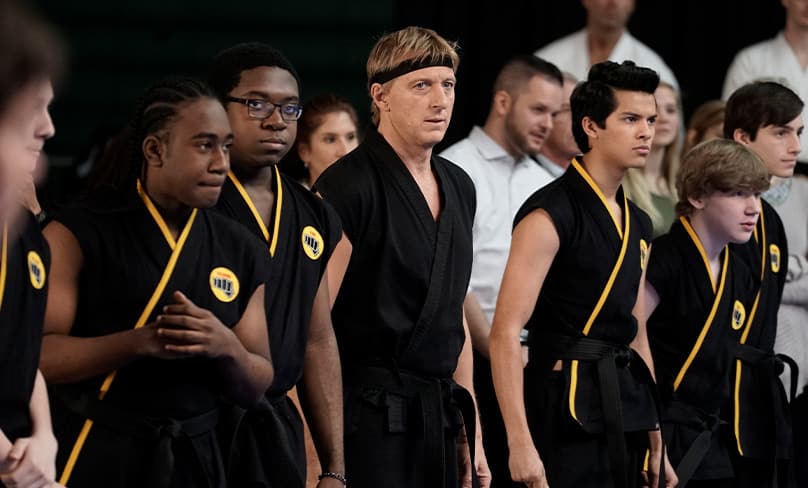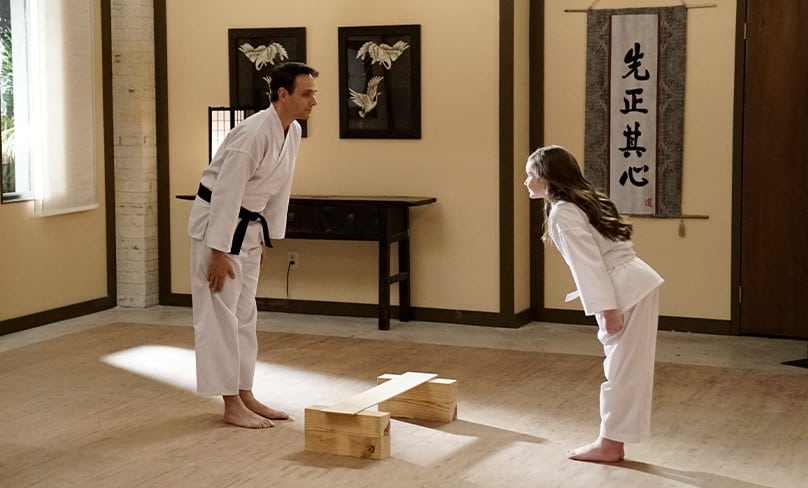
For the past decade, the film industry has been going through a kind of mid-life crisis.
Looking back at its achievements with Nostalgia-tinted glasses, the cinematic world desperately tries to spark new interest by recreating its most memorable moments.
From Total Recall to Jurassic Park, few blockbusters have escaped the jaws of the reboot without serious backlash.
One exception is Netflix’s newly acquired take on The Karate Kid classic, Cobra Kai, created by Harold and Kumar writers Jon Hurwitz and Hayden Schlossberg.
It was at the beginning of The Karate Kid part II, where we last saw Daniel LaRusso (Ralph Macchio) and Johnny Lawrence (William Zabko) together.
Daniel had just won the All-Valley Karate Championship, under the guidance of Mr Miyagi (Pat Morita), while Lawrence left the Cobra Kai Dojo in disgrace after his sensei John Kreese (Martin Kove) violently reprimands him for his failure.
“This encounter does little to shake the image each has for the other and soon the rivalry reignites.”
Jump forward 30 years and life, for both men, seems to have unfolded according to the events of that faithful day in 1984.
Daniel, through the support of Mr Miyagi, has established a successful car dealership while living comfortably with his loving wife Amanda (Courtney Henggeler) and two kids Samantha (Mary Mouser) and Anthony (Griffin Santopietro).
Whereas Johnny, after a lonely life of partying, has found himself unemployed, estranged from his son Robby (Tanner Buchanan) and living alone in a rundown apartment.
The two rivals reunite after a hit and run accident, involving daughter Samantha LaRusso, leaves Johnny’s car badly damaged.
This encounter does little to shake the image each has for the other and soon the rivalry reignites with both men starting their own competing Karate Dojos.
The critically-acclaimed series was launched on YouTube Red in 2018 with its first episode being viewed 5.4 million times within the first 24 hours, according to market research company Parrot Analytics.
Both first and second seasons, for more than a month, were considered the world’s most in demand digital series and upon its 2020 relaunch on Netflix drew nearly 2.2 billion streaming minutes in the United States alone.
With so many failed attempts at rebooting classic 80s franchises, including such recent train wrecks as Ghost Busters and Charlie’s Angels, why has this Karate Kid continuation not only survived the comeback but have crane-kicked their rivals out of the competition?
The answer to its success, just like that of a practitioner of Karate itself, is dependent on the way it finds balance in its themes and storylines, respects the franchise’s well-established traditions, builds upon its foundations to reach new ground and at its core is driven by pursuit of good and redemption (however misled at times it might be).
Cobra Kai creators Jon Hurwitz and Hayden Schlossberg, who are also the series writers, directors, executive producers and above all else its fans, have not used their show as a vessel to preach their woke propaganda or make commentary on certain political figures (unlike most recent reboots) but instead focused on keeping the material faithful to the films in message and meaning for the benefit of the franchise as a whole.
“In building upon this iconic rivalry and taking ownership over the now widely accepted perception that neither Johnny or Daniel were all good or all bad, writers Hurwitz and Schlossberg have been able to explore their relationships.”
This is no better demonstrated than in the 30-plus-year rivalry between Daniel LaRusso and Johnny Lawrence which motivates this whole series.
From the moment Cobra Kai Sensei John Kreese uttered the words “sweep the leg” at the 1984 All-Valley Karate Championship finals, Johnny’s fate as the villain of The Karate Kid story was sealed.
For three decades that image remained with the character and followed actor William Zabka throughout most of his acting career.
But in the last decade, with the help of such TV shows as How I met your Mother and songs such as Sweep the Leg by No More Kings, this image has flipped and it is Daniel LaRusso who many have called out to be the real villain of the film through his pursuit of Johnny’s girlfriend Ali and in the questionable way he won the championship.
In building upon this iconic rivalry and taking ownership over the now widely accepted perception that neither Johnny or Daniel were all good or all bad, writers Hurwitz and Schlossberg have been able to explore their relationships (as well as other key relationships) in new and engaging ways while keeping true to the heart of The Karate Kid films.

The great chemistry between the entire cast, particularly actors Ralph Macchio and William Zabko, play a pivotal role in this series satisfying old fans and attracting new ones.
Macchio and Zabko’s portrayal of these characters, 30-odd-years after the events of the first film, is played to almost perfection especially when you take in account the way in which their lives have changed since then.
Fan service can make or break a rebooted film or TV series, but unfortunately for those who walk that tightrope … it is essential.
You only have to look as far as the recent Star Wars trilogy to see how one can alienate a large part of your audience while disengaging the rest.
Though at times a little excessive, Cobra Kai does well to provide fan service through the use of flashbacks, throwbacks, imagery, sets, items and cameos from previous films.
“For those who have not yet caught onto the Karate Kid craze, you can fly kick through the first two seasons with each of the sixteen episodes running only for approximately 30 minutes.”
But by doing these things with respect, meaning and an intent to deepen the story, the series usually finds the right balance particularly when it comes to paying homage to Pat Morita’s Mr Miyagi.
What is most impressive about Cobra Kai’s fan service is the way that the creators have intertwined it between the show’s teenage drama element in order to keep both young and old audiences engaged for the entirety of the series.
This is evident in the storylines of characters Miguel Diaz, Samantha LaRusso and Robby Keene which are deeply rooted and effected by those of Daniel LaRusso and Johnny Lawrence.
For those who have not yet caught onto the Karate Kid craze, you can fly kick through the first two seasons with each of the sixteen episodes running only for approximately 30 minutes.
With public demand forcing the early release of Cobra Kai’s third season on 1 January and a fourth season already confirmed, it is clear that true to its slogan, ‘Cobra Kai Never Dies’.
Related Articles
